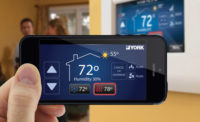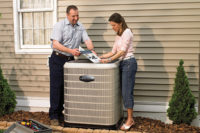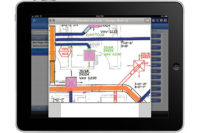But there is a way to make tech trends understandable to customers. Talk in everyday language and be sure you know what you are talking about. It also helps to listen to their concerns and then explain the benefits of the technology that specifically match up with what has been worrying them.
What Do Clients Look For?
For example, besides energy efficiency, cost savings, and comfort, what do your customers look for? Or, what do they listen for?
The iQ Drive heat pumps from the Maytag, Broan, Frigidaire, NuTone, Tappan, and Westinghouse lines are known for what they don’t do — which is make noise. “Sound ratings are as low as 59 db,” said Matt Lattanzi, director of product management, Nordyne. “The unit is so quiet, sometimes the homeowner has to step outside to make sure it’s running.”
Energy efficiency doesn’t take a backseat, though. According to Lattanzi, based on a 36,000 Btuh unit in the Southeast at $0.08/kWh, annual operating cost can be as low as $560. “The product fits into any HVAC contractor’s business model because iQ Drive heat pumps help the contractor go beyond good-better-best to ultra best,” he said. “Offering this super-energy-efficient model distinguishes the contractor from other bids the homeowner may be receiving.”
Speaking of high-efficiency, geothermal heat pumps are also part of a growing popular tech trend.
“Geothermal is the most efficient way to heat and cool,” said Tim Litton, director of marketing, WaterFurnace International Inc. “It provides savings from 30 to 70 percent over traditional systems.
“Homeowners are moving past the green buzz of recent years and are embracing the underlying concept of energy efficiency. They’re increasingly searching for ways to maximize dollars and their family’s comfort. Contractors who want to service this market and capitalize on one of the fastest growing segments of HVAC can no longer afford to overlook geothermal heat pumps.
“In studies, consumers have cited energy efficiency, comfort and long-term financial savings as larger considerations than initial price when replacing an HVAC system. This helps explain the surging adoption of geothermal. Although it carries higher upfront costs, it offers homeowners the most energy-efficient, cost-effective, and comfortable way to condition a home.”
In addition to saving on heating costs, saving on water costs and consumption is another attractive tech trend to consumers. “Since today’s homeowners face rising energy costs and higher utility bills, the efficiencies and synergies derived from the Rheem Integrated System can help them reduce their heating and water heating energy usage,” said Sal Brunetto, national accounts sales manager, Rheem. “For instance, when paired with the Rheem Prestige™ Series condensing tankless water heater, which operates at 94 percent efficiency, the space-heating portion of the system will be just as efficient.
“When the Rheem hydronic air handler is matched with a Rheem tankless gas water heater, hot water is circulated through the air handler to produce heat and is then re-circulated back to the tankless water heater to ensure that no water is wasted. This system is a great way for contractors to expand knowledge and experience, helping to bridge the gap into water heating offerings and increased business. Contractors that do begin carrying this system are pleased to learn that the modulating combustion features of the tankless heater are comparable to advanced modulating furnaces.
“For contractors that already understand the mechanics of air handlers, learning the Rheem Integrated Heating & Water Heating System — which features an innovative hydronic air handler — is a natural fit, and it helps them provide homeowners with one solution for both heating and water heating.”
Brush Up on the Latest
If contractors want to talk tech with customers on some of an HVAC system’s inner workings, they might want to brush up on variable-frequency drives (VFDs) and how these products relate to higher efficiency.
“The main driver compelling customers across industries to consider variable-frequency drives continues to be energy savings and the associated cost savings,” said Robert Fenton of Eaton. “When you apply a drive on a fan or pump, the return on investment can be realized in as little as eight months.
“For more than 40 years, drives have been a critical component for improving energy efficiency, reducing wear and tear on valuable motor and pump assets, and improving system reliability and uptime. Although they are fundamentally used the same way, drive technology has evolved and improved — yielding drives that are better able than ever to reduce energy consumption and improve reliability, while extending equipment life. And they are able to do so in a compact footprint.
“The increasing cost of energy and interest in improving the efficiency of buildings and processes is driving sales and compelling manufacturers to make drives even more efficient. Manufacturers, like Eaton, are investing in the research and development of algorithms used within drives to run motors and drives even more efficiently. One example is the Eaton H-Max drives.”
Speaking of technology that benefits contractors, Unico Inc. has a way for contractors to directly control their customer’s comfort levels. “Our Green series air handler, which has an EC motor and a configuration software application (ECconfig), allows the contractor to precisely set the cfm output of the air handler for low and high cool, low and high heat, ventilation and emergency heat, as well as the motor rpm for the same settings,” said Randy Niederer, director of marketing, Unico. “The contractor uses a laptop to connect directly to the SMART (Software Managed Air Rate Technology) control board to change the settings.
“We have found it to be very user friendly for the contractor and it has given them the ability to provide the homeowner with the proper airflow required to heat, cool, and ventilate their homes.”
Unit heaters are another popular heating option that offer energy savings and high-tech features that building owners find very appealing, according to John Garavelli of Reznor/Thomas & Betts.
“When the fuel efficiency is combined with the electrical motor efficiency, Reznor units cost less to operate than other comparable heaters,” he said. “Units feature vertical or horizontal venting and the Reznor concentric adapter kit makes it so only one roof or wall penetration is necessary for venting.
“Some advantages of the Model UES include the smooth aerodynamic design of the Reznor MacroChannel, which allows air through the heater and down to the floor where it is needed.”
The MacroChannel will not collect dust, lint or other debris.
“And additionally, the Model SHH produces more Btus per cubic foot of natural gas than contemporary split systems. It is ideally suited for the Optimized Energy Performance credit through the LEED program.”
These products are a sampling of the technology that HVAC contractors have at their fingertips — technology that continues to evolve and bring energy efficiency, lower costs, and comfort to the people who matter the most: their customers.
Sidebar: Web-Based Computing for Contractors
John Chaney, president and cofounder of Dexter + Chaney, maker of construction software, offered some input on what he termed the three major waves of change in the past three decades. The first wave was the advent of personal computing. The second was the emergence of mobile computing and communication. A third wave is web-based computing, which he said “holds great promise for contractors who take advantage of it.”
According to Chaney, “You can’t easily see a very big wave in deep water as it makes its way to shore. But when it gets there and breaks, you can do one of two things: run from it or ride it. A wave of web-based computing is about to break and those who chose to ride it will benefit in several ways: ease of use, accessibility, and lower cost of ownership.”
Chaney explained that today people are used to Google searches, web access to their bank accounts, social networking on Facebook, and shopping on Amazon.com. These web-based applications are easy to use, Chaney noted, allowing “users to move quickly with single-click choices and easy-to-understand options.”
Similarly, he said, “Contractors who embrace web-based applications will find that they are easier to use because they have to be. Software designed for use on multiple devices via web browsers must operate in an environment of limited screen real estate and unknown processing and memory power. So user interfaces must be simplified and be intuitive.”
Chaney continued to explain that more powerful business applications can be delivered on less powerful and less accommodating computing devices because “processing and storage can take place online, allowing contractors to access full-featured business and construction software using any connected device that has a web browser.” He added, “This allows field staff to use their mobile devices for more than dispatch acknowledgement and time entry. They can access full repair histories, equipment and parts databases, and update this information in real time.”
In addition, web-based computing also allows contractors the benefits of mobility and constant access. “True mobility only occurs when you can cut the tether that ties you to constant software updates and hardware upgrades, and this is what web-based applications deliver,” Chaney said.
“Your staff has anywhere, anytime, any-device access to the applications they need and you enjoy freedom from worrying about keeping them updated and upgraded. And with this type of access and freedom comes better connection among your staff.”
Publication date: 01/30/2012






